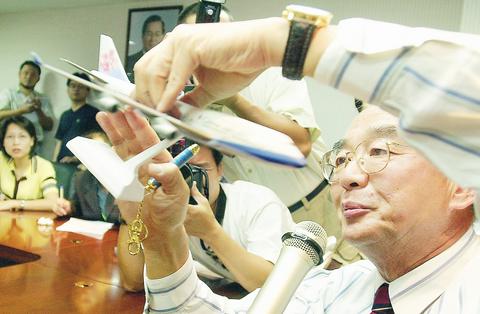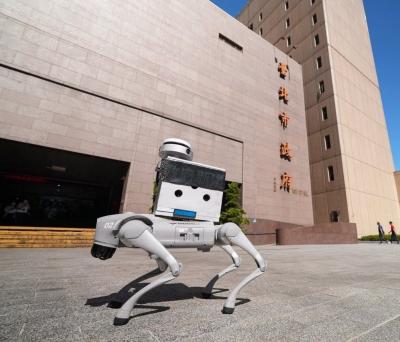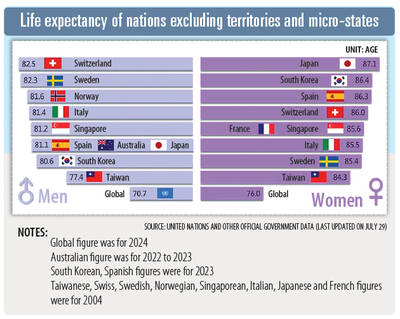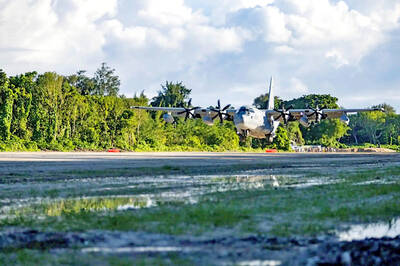After over two months of investigation, the Cabinet's Aviation Safety Council (ASC) yesterday said that the break-up of a China Airlines jumbo jet over the Taiwan Strait in May likely began in the section of the aircraft between the wing and the tail.
So far, the cause of the China Airlines crash has been a mystery. The pilots of the Boeing 747-200 reported no problems before the plane broke apart about 20 minutes into a flight from Taipei to Hong Kong on May 25. Security officials have said there were no signs of terrorism or a missile attack.
"Since the suspicious pieces of wreckage were mostly from section 46, it is very likely that it was where the aircraft first broke-up," said Kay Yong (

PHOTO: LIAO CHEN-HUI, TAIPEI TIMES
There are four main pieces of wreckage from the mid-rear portion of the airliner, and one of the four sections, section 46, is the main focus of attention.
Yong was speaking following yesterday's monthly ASC meeting.
Samples from the four pieces of wreckage were sent to laboratories at the Chung Shan Institute of Science and Technology (
According to Yong, investigators have found "non-destructive fractures" on two pieces of the "suspicious" wreckage, which are from the fifth exit on the left side and from the bulk cargo door panel.
"Non-destructive fractures are not caused during accidents or when an aircraft crashes into the sea," he said.
"From the smooth cuts of the fractures, it is not hard for aviation experts to see that these fractures are the result of metal fatigue."
Yong showed a photograph of a 20.3-inch-long flat non-destructive fracture in the bulk cargo door panel, saying "This is the one you guys are interested in," adding that the panel in question was repaired in February 1980 after a "tail strike" -- when the rear of the aircraft hit the runway as a result of taking off at too steep an angle.
A report in last Friday's Washington Post referred to a "fatigue crack in the rear fuselage" and cited an anonymous source describing it as the first physical evidence pointing to a possible cause of the accident.
Yong, however, refused to speculate on whether the fractures were responsible for the accident.
"These are unusual cracks. However, whether the cracks have anything to do with the [airliner's] breakup will have to be further studied."
Yong said investigators also found "spiked-tooth shaped" damage on the lower portion of the fourth exit on the left side of the aircraft which "might be the result of a strike with high energy impact."
He said that the fourth piece of wreckage included, "a piece of the aft cargo door which seemed to have been ripped off by strong force."
Yong said it was too early to say what happened to the door, but he told reporters that it was "very likely that the portion [of the plane] near the cargo door was the first part to break off."
Kay also said that investigators have ruled out the possibility of explosive decompression, conclusively ruling out the possibility that the aircraft exploded.
"From the examination of the retrieved wreckage and bodies, the plane suffered from rapid decompression rather than explosive decompression," Yong said.
Explosive decompression is sudden, extremely quick, and involves high-energy impact while rapid decompression takes longer to develop and involves a slower release of energy.
"We could not yet determine whether the aircraft broke up because it suffered from rapid decompression or whether the decompression in the cabin led to the breakup," he said.

The inspection equipment and data transmission system for new robotic dogs that Taipei is planning to use for sidewalk patrols were developed by a Taiwanese company, the city’s New Construction Office said today, dismissing concerns that the China-made robots could pose a security risk. The city is bringing in smart robotic dogs to help with sidewalk inspections, Taipei Deputy Mayor Lee Ssu-chuan (李四川) said on Facebook. Equipped with a panoramic surveillance system, the robots would be able to automatically flag problems and easily navigate narrow sidewalks, making inspections faster and more accurate, Lee said. By collecting more accurate data, they would help Taipei

STATS: Taiwan’s average life expectancy of 80.77 years was lower than that of Japan, Singapore and South Korea, but higher than in China, Malaysia and Indonesia Taiwan’s average life expectancy last year increased to 80.77 years, but was still not back to its pre-COVID-19 pandemic peak of 81.32 years in 2020, the Ministry of the Interior said yesterday. The average life expectancy last year increased the 0.54 years from 2023, the ministry said in a statement. For men and women, the average life expectancy last year was 77.42 years and 84.30 years respectively, up 0.48 years and 0.56 years from the previous year. Taiwan’s average life expectancy peaked at 81.32 years in 2020, as the nation was relatively unaffected by the pandemic that year. The metric

TAKING STOCK: The USMC is rebuilding a once-abandoned airfield in Palau to support large-scale ground operations as China’s missile range grows, Naval News reported The US Marine Corps (USMC) is considering new sites for stockpiling equipment in the West Pacific to harden military supply chains and enhance mobility across the Indo-Pacific region, US-based Naval News reported on Saturday. The proposed sites in Palau — one of Taiwan’s diplomatic allies — and Australia would enable a “rapid standup of stored equipment within a year” of the program’s approval, the report said, citing documents published by the USMC last month. In Palau, the service is rebuilding a formerly abandoned World War II-era airfield and establishing ancillary structures to support large-scale ground operations “as China’s missile range and magazine

Passengers on Taiwan High Speed Rail (THSR) will be required to use headphones and make phone calls in gangways under new “quiet travel” rules starting Sept. 22. THSR Chairman Shih Che (史哲) told media that THSR will run a three-month promotional campaign to ensure widespread adoption of the new rules. Those repeatedly ignoring the guidance face the potential termination of their transport contract, which can result in them getting escorted off the train, according to THSR. Shih shared his hope to cultivate an environment conducive to rest and reading for the train’s passengers, stating that these changes aim to “promote self-discipline” among passengers